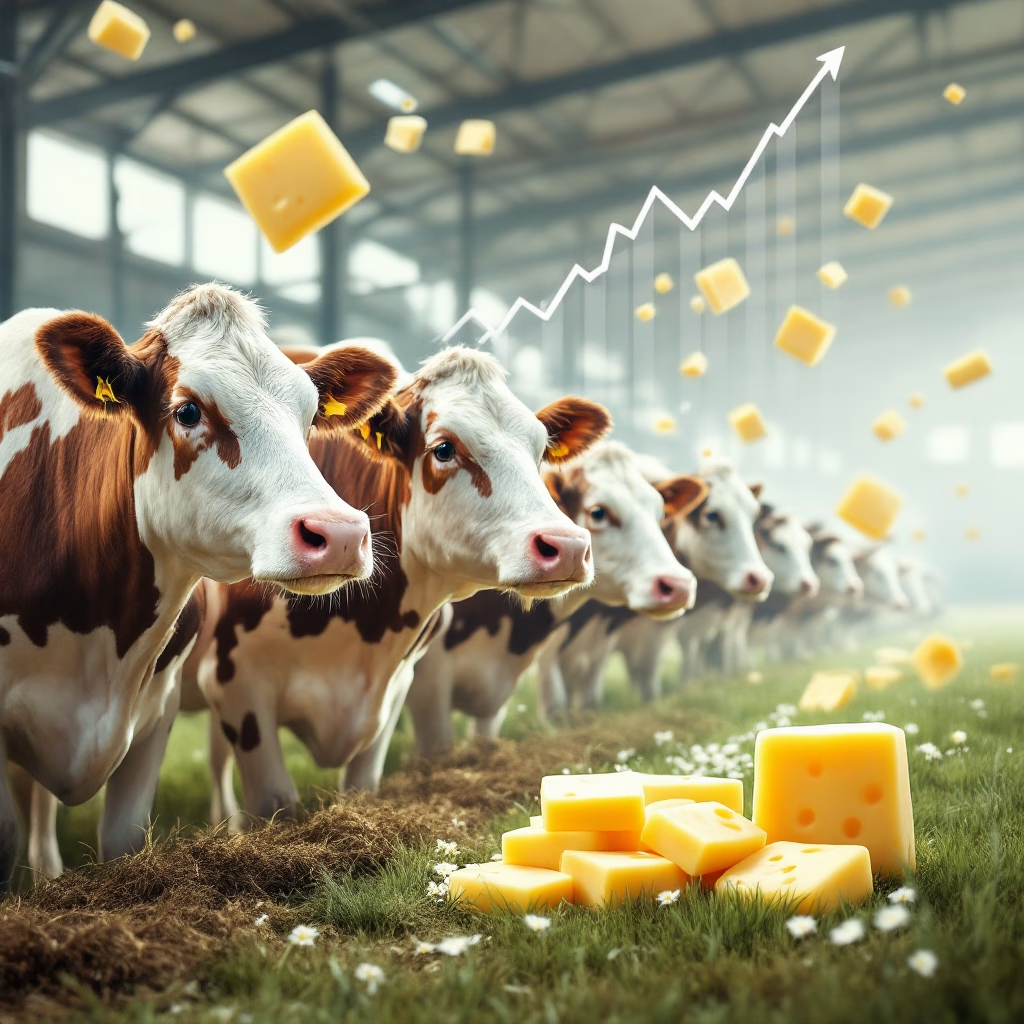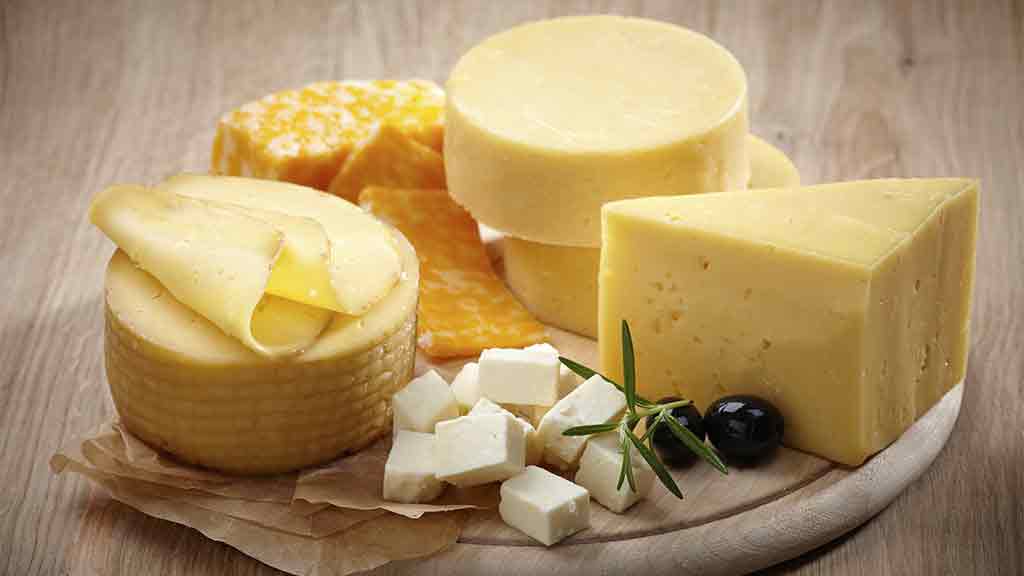Check out why Class III milk and cheese prices are reaching new highs, even with slow production. What’s behind this trend?
Summary:
Class III milk and cheese have kicked off 2025 with a bang, hitting new contract highs. After the holiday break, cheese prices are up, with barrels and blocks at $1.875 each. This rise comes even though cheese production dipped and there’s been a big demand for butter, which is pulling milk in a different direction. It’s an interesting mix, showing how interconnected the dairy market is. With more than 200 cheese options traded for the upcoming months, there’s a lot of excitement in futures trading. This strong start hints at good prospects for the dairy industry this year, offering potential gains for those involved in milk production and processing. As always, the dairy scene is changing fast, driven by shifts in consumer demand, production, global trade, and the economy.
Key Takeaways:
- Cheese markets hit new contract highs with increased trading volumes as the holiday period concludes.
- November’s cheese production was significantly lower than anticipated, falling 33 million lbs. short of forecasts due to various interpretations of demand and production dynamics.
- Butter demand appears to be influencing milk allocation priorities, potentially detracting from cheese production.
- Spot cheese average reached two-month highs, with barrel and block prices on the rise.
- Class III milk futures have seen a robust start to 2025, reaching new contract highs through April.
- Market movements indicate strong butter demand and higher NFDM/SMP production, suggesting shifts in consumer preferences and manufacturing outputs.
- The dairy market continues to navigate the complexities of production adjustments while responding to dynamic demand patterns.

Who would’ve guessed that cheese, a simple dairy product, could stir such excitement? But here we are, with Class III milk and cheese markets hitting new highs, attracting everyone from dairy farmers to traders. Last year, cheese makers cut back production due to low demand, but prices are soaring. Spot cheese prices haven’t been this high in two months, with barrels reaching $1.875 and blocks seeing gains, too. Interest is buzzing in futures trading, with over 200 cheese options traded for upcoming months. A blend of low inventory, production challenges, and consumer demand makes this surge fascinating, setting the stage for the dairy industry’s 2025 outlook.
| Category | October 2024 | November 2024 | YoY Change (%) |
|---|---|---|---|
| Cheese Production (lbs.) | 1.226 billion | 1.151 billion | -1.7% |
| Butter Production (lbs.) | 164.4 million | 167.8 million | +2.1% |
| NFDM/SMP Production (lbs.) | 166.3 million | 167.2 million | +0.5% |
| Class III Milk Price (per cwt) | $19.01 | $19.50 | +2.6% |
Class III Milk and Cheese Markets Begin 2025 on a High Note
Welcome to our look at the shifting dairy markets as 2025 kicks off. We’ll examine the significant changes in Class III milk and cheese, focusing on the noteworthy rise in spot cheese prices to their highest in two months. We’ll explore why cheese production has dipped and how increased butter demand changes how dairy resources are used. This article provides a closer look at what’s happening in the industry, helping you understand market changes and what might come next.
Spot cheese prices have hit levels not seen in the past two months, with both barrel and block cheese prices climbing steadily. Barrel cheese rose to $1.8750 per pound, hitting a mark last reached in October, while block cheese climbed to $1.9400 per pound.
Futures trading volumes have also surged, reflecting renewed market interest after the holiday lull. For dairy farmers and industry players, these price movements are crucial. New contract highs for Class III indicate strong future performance and potential profitability for those in milk production and processing. With nearby Class III futures jumping after the spot cheese price rise—especially with February contracts hitting $21.12 per hundredweight—there’s a sense of optimism about market strength.
This trend reflects a mix of supply and demand factors. Despite weaker production reports suggesting sluggish cheese demand, inventory limits and production drops, like the 33 million-pound deviation from forecasts, show the market’s sensitivity to supply changes. These shifts challenge producers to adapt and offer opportunities for strategic decisions in production and marketing.
These developments highlight the need for vigilance and adaptability in the dairy market. Staying informed about current trends and forecasts is key to maximizing new opportunities and navigating potential challenges in this ever-changing landscape.
Cheese Production Takes a Curious Turn: Decoding the November Dip
Cheese production last November was relatively reduced, falling 33 million pounds short of expectations, leaving experts puzzled. Let’s examine why cheese output might have dipped and what this means for the dairy industry.
- Weak Demand: Could low demand be the reason? Cheese consumption may have decreased by 3% in November compared to the previous year. We’ll know for sure once new import/export data is released. This isn’t the first time cheese makers have reduced production due to less local demand. Is this a repeat of what happened in early 2024?
- Expected New Capacity: Cheesemakers might have expected new facilities to start producing cheese, but that didn’t happen as soon as they thought. If the new facilities were delayed, producers might have limited their cheese production, waiting for the new sites to operate thoroughly. It’s a puzzling and complex situation.
- High Butter Demand: November also saw a massive demand for butter, which might have redirected milk from cheese making. It’s as if the high demand for butter redirected the milk from the cheese-making processes. However, even if butter demand soared, there was plenty of cream, raising questions about whether milk was genuinely taken from cheese or if there was just an excess of fat to use. Perhaps it’s prudent to approach this theory cautiously and delve deeper into its implications.
While all these ideas are possible, only time and future data will reveal the reason behind the mystery of cheese production. One thing is sure: the dairy industry is constantly in flux, requiring everyone involved to remain vigilant and adaptable. What do you think about this issue?
The Butter Demand Phenomenon: A Powerful Force Reshaping Dairy Resource Allocation
The dairy market is abuzz with excitement about unexpected butter demand shifts. In this industry, every gallon of milk serves a purpose, and right now, butter demand is steering those resources.
Recent reports offer an intriguing insight: Despite California’s production issues due to HPAI, butter and NFDM/SMP production are up, defying expectations. For those passionate about the dairy market, this underscores the robust domestic craving for butter, which is making significant waves.
But here’s the kicker: How is butter demand boosting production despite forecasts of decline? Plenty of cream is giving butter makers the chance to increase production. This cream, left over from weaker demand for other dairy products, allowed for a production boost to meet consumer demand and stock up for the future.
This unexpected rise in production presents many aspects to consider:
- Continued butter demand likely means butter prices stay high, making it profitable.
- With milk being directed to butter, cheese makers may face limitations unless new sources emerge or solutions are found.
- The NFDM/SMP production increase suggests strategic planning, potentially buffering against future market changes.
Continued vigilance and analysis of these trends are imperative to anticipate market shifts and make informed decisions. The dairy industry must adapt quickly and ensure that milk is allocated efficiently to meet demand. Production increases amidst anticipated declines showcase industry resilience, offering growth opportunities and posing challenges in supply chain management and market positioning.
Swift Market Reactions Reflect Dynamics in Production and Demand
Market responses to recent changes in production and demand have been quick, especially with nonfat dry milk(NFDM) trades and spot butter prices. Spot butter prices reaching $2.5700 per pound indicate robust and sustained demand, suggesting stability in the market.
The NFDM market is also buzzing with activity. Recently, 11 lots were traded heavily, hinting at the market’s response to global price changes and economic data, especially from China.
Key factors affecting these markets:
- Consumer demand changes: Strong butter demand may mean shifts in what consumers want, keeping prices up.
- Production changes: Producers’ reaction to recent drops by boosting production will affect inventory and prices.
- Global trade impacts: Import and export activities could heavily impact cheese supplies and demand.
- Economic shifts: Wider economic conditions, such as GDP growth, inflation, and job rates, could affect consumers’ spending on dairy.
It’s essential to note that dairy markets often undergo seasonal fluctuations, such as price decreases post-holidays, which precede the emergence of new market trends for the upcoming year. With recent highs in Class III milk futures, market players are watchful, considering how far prices will rise or fall in the coming months. Successfully navigating these markets requires thoughtful planning and adaptability.
The Bottom Line
As we look into the dairy market, it’s clear that some significant changes are happening. Despite favorable market conditions, the unexpected decline in cheese production underscores the need for experts to monitor the situation closely. Equally important is the strong demand for butter, which affects how milk is used and changes production plans. These shifts highlight why it’s essential to stay updated with industry news. You can better understand and predict market trends by following insights from places like The Bullvine. This piece shows why staying informed and in touch with essential industry sources is key. Whether you’re strategizing for the future or making immediate business decisions, understanding these evolving trends will keep you ahead of the curve.
Learn more:
- Flying Through Uncertainty: Domestic Cheese Demand Spurs Record Highs in Class III Futures Amid Global Market Shifts
- Will the Surge in Milk Prices Last? Analyzing Trends and Future Outlook
- US Milk Production Declines for 11th Month While Butterfat and Protein Rise
 Join the Revolution!
Join the Revolution!
Bullvine Daily is your essential e-zine for staying ahead in the dairy industry. With over 30,000 subscribers, we bring you the week’s top news, helping you manage tasks efficiently. Stay informed about milk production, tech adoption, and more, so you can concentrate on your dairy operations.







 Join the Revolution!
Join the Revolution!







